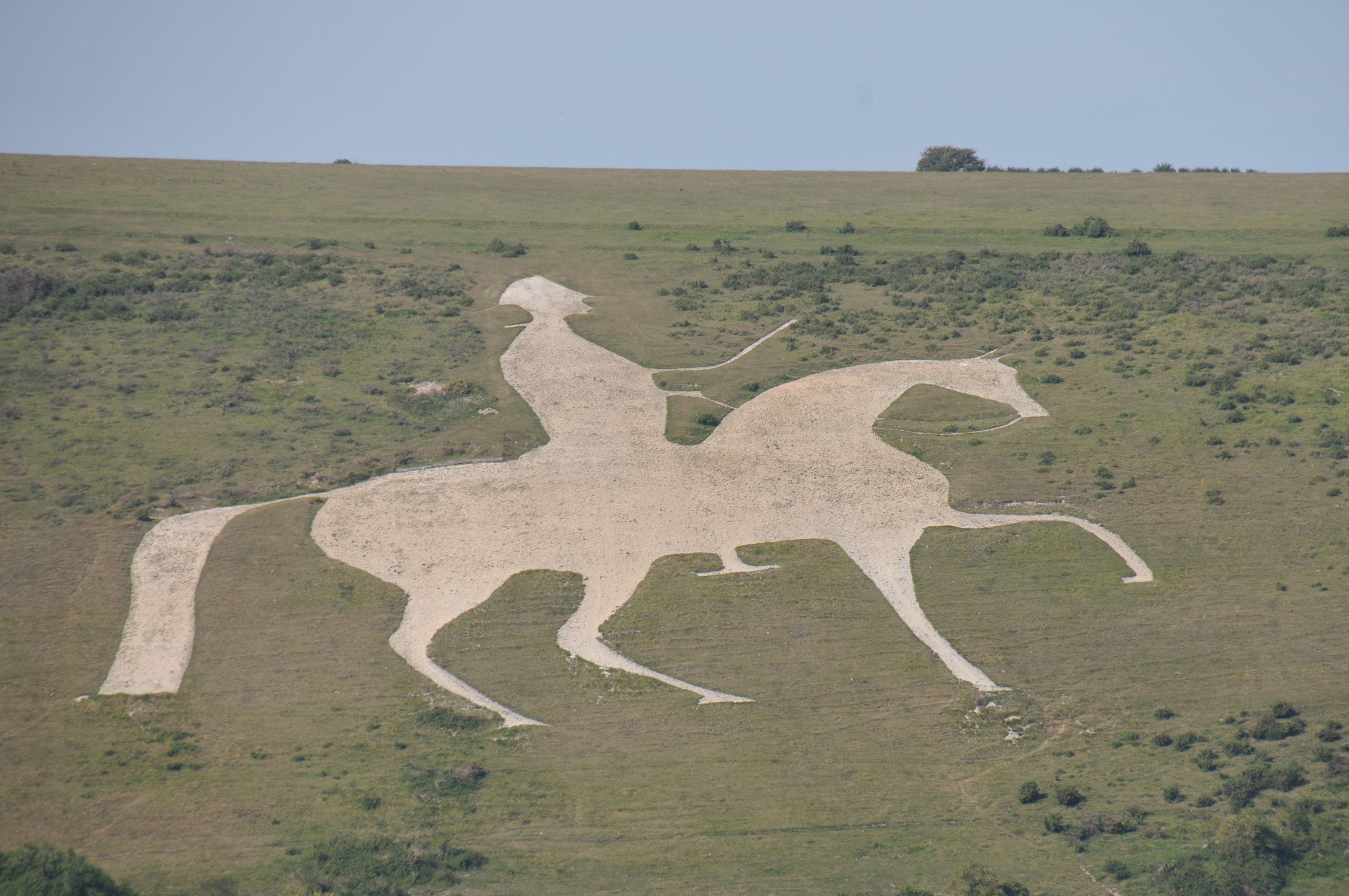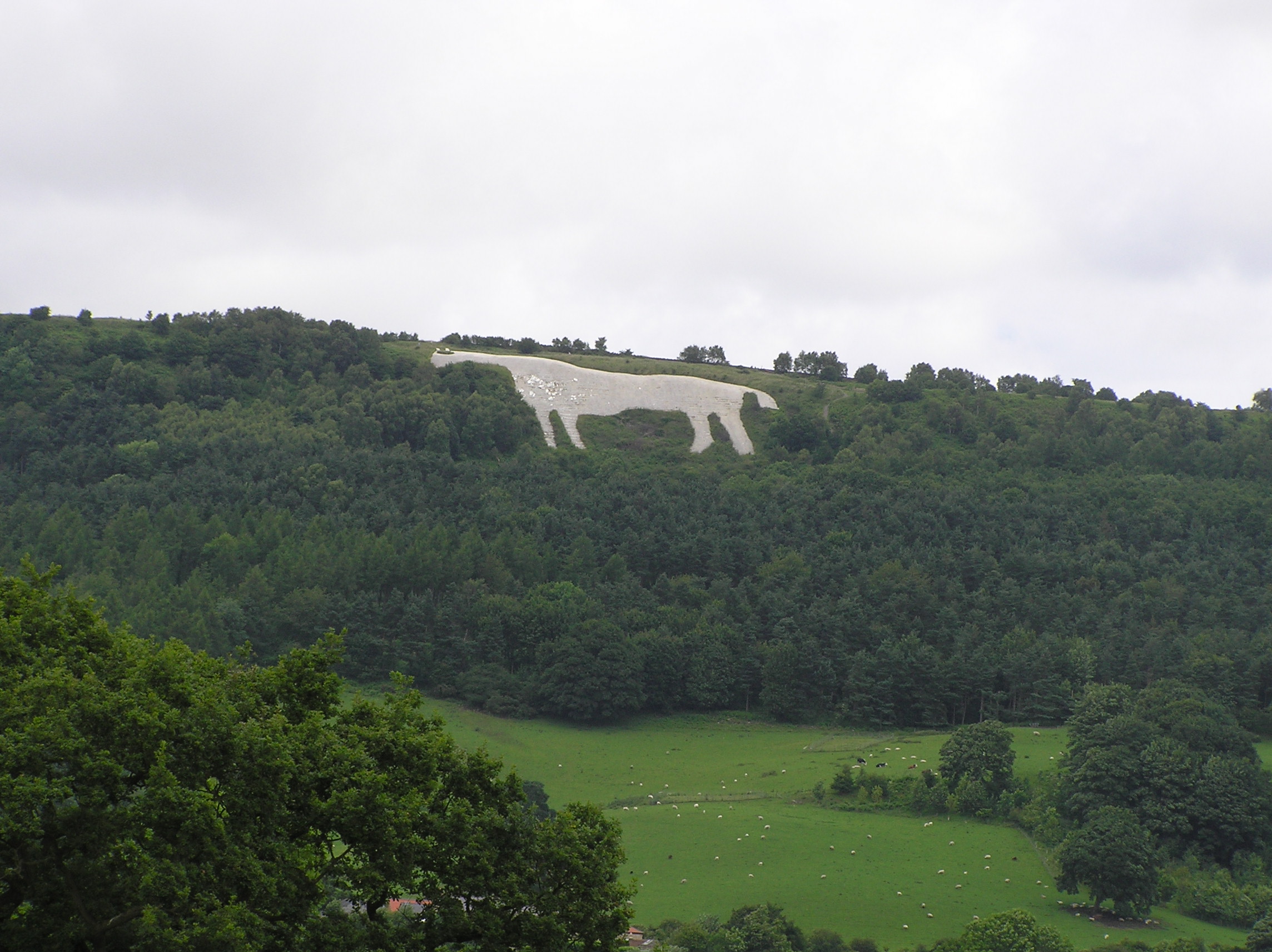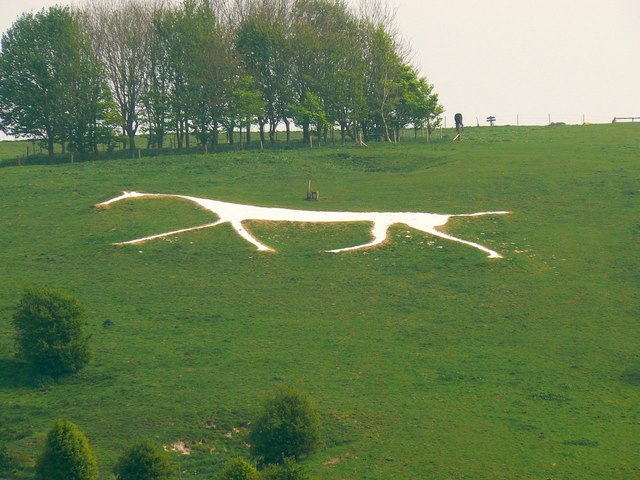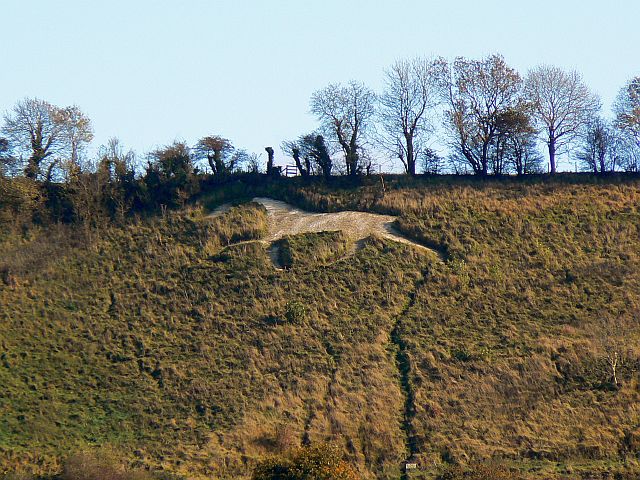|
Litlington White Horse
The Litlington White Horse is a chalk hill figure depicting a horse, situated on Hindover Hill (known locally as High-and-Over) in the South Downs, looking over the River Cuckmere to the west of the village of Litlington and north of East Blatchington in East Sussex, England. The current horse was cut in 1924 by John T, Ade, Mr Bovis and Eric Hobbis in a single night and stands at 93 feet long and 65 feet high. A previous horse was cut in either 1838 or 1860 on the same site. Since 1991, the horse has been owned by the National Trust, who, along with local volunteers, regularly clean and maintain the horse. The Litlington White Horse is one of two hill figures in East Sussex; the other being the Long Man of Wilmington which is situated 3 miles north-east from the White Horse. Original Litlington White Horse The origin and date of the original White Horse is debated. One view is that it was created by James Pagden of Frog Firle Farm, along with his two brothers and cousin ... [...More Info...] [...Related Items...] OR: [Wikipedia] [Google] [Baidu] |
Litlington, East Sussex
Litlington is a village and former civil parish, now in the parish of Cuckmere Valley, in the Wealden district, in the county of East Sussex, England. It is focussed ENE of Seaford on the south coast. It was in a roughly square parish of dramatic chalkland that extends down to a natural coastline of pebble beach, Cuckmere Haven. In 1961 the parish had a population of 117. On 1 April 1990 the parish was abolished and merged with Lullington and Westdean to form Cuckmere Valley. Toponymy The name is Saxon, and literally means Litl's (followers or possibly family's) homestead. It is also potentially a corruption of Littleton but there is no evidence for its missing its -ing component. Parish description The village is small and like the rest of the parish, which extends to take in much of the Seven Sisters Country Park is on the left bank of a narrow valley in the signature narrow band of the South Downs National Park. It is downriver followed only by marshes mainly to its s ... [...More Info...] [...Related Items...] OR: [Wikipedia] [Google] [Baidu] |
Unicorn
The unicorn is a legendary creature that has been described since antiquity as a beast with a single large, pointed, spiraling horn projecting from its forehead. In European literature and art, the unicorn has for the last thousand years or so been depicted as a white horse-like or goat-like animal with a long straight horn with spiralling grooves, cloven hooves, and sometimes a goat's beard. In the Middle Ages and Renaissance, it was commonly described as an extremely wild woodland creature, a symbol of purity and grace, which could be captured only by a virgin. In encyclopedias, its horn was described as having the power to render poisoned water potable and to heal sickness. In medieval and Renaissance times, the tusk of the narwhal was sometimes sold as a unicorn horn. A bovine type of unicorn is thought by some scholars to have been depicted in seals of the Bronze Age Indus Valley civilization, the interpretation remaining controversial. An equine form of the unicorn ... [...More Info...] [...Related Items...] OR: [Wikipedia] [Google] [Baidu] |
Osmington White Horse
__NOTOC__ The Osmington White Horse is a hill figure cut into the limestone of Osmington Hill just north of Weymouth in Dorset in 1808. It is in the South Dorset Downs in the parish of Osmington. The figure is of King George III riding his horse and can be seen for miles around. The king was a regular visitor to Weymouth and made it 'the first resort'. The figure is long and high and is best viewed from the A353 road. In 1989 the figure was restored for a broadcast of the TV show ''Challenge Anneka'', although the work was subsequently criticised by historians for doing more harm than good. Anneka Rice, presenter of the show, stated that planning permission and advice had been sought before the work. In August 2011 pranksters added a 'horn' made from plastic sheeting to make the horse resemble a unicorn. In 2012, it was announced that for the Olympics 2012, the horse would be cleaned and slightly recut to make it look like the original when it was cut in 1808. Restoration ... [...More Info...] [...Related Items...] OR: [Wikipedia] [Google] [Baidu] |
Marlborough White Horse
Marlborough White Horse, also called the Preshute White Horse, is a hill figure on Granham Hill, a fairly shallow slope of the downland above the hamlet of Preshute, southwest of Marlborough in the county of Wiltshire, England. Dating from 1804, it is one of several such white horses to be seen around Great Britain, and one of nine in Wiltshire. Many distant views of the horse are obstructed by trees, but it can be seen from parts of the town of Marlborough. One good view is from a footpath running from Preshute House to the A345 road. The figure is some 500 metres south of Marlborough College, within 100 metres of the southeast corner of the college sportsground. History The smallest such horse in Wiltshire, the Marlborough horse was cut in 1804 by boys at Mr Greasley's Academy, also called the High Street Academy, a school in Marlborough High Street which occupied the building now The Ivy House Hotel. This was not the present-day Marlborough College, which is only a short dist ... [...More Info...] [...Related Items...] OR: [Wikipedia] [Google] [Baidu] |
Kilburn White Horse
The Kilburn White Horse, , is a hill figure cut into the hillside in the North York Moors National Park near Kilburn in North Yorkshire, England. The figure is long by high and covers about and said to be the largest and most northerly hill figure in England. Located on the southern flank of Sutton Bank, near Roulston Scar at the edge of the Hambleton table-land, it faces south-south-west and is visible from some distance, particularly from the East Coast Main Line railway south of Thirsk, and from the A19. On a clear day, the horse is visible from north Leeds, away on the higher ground to the west of the Vale of York. Sutton Bank, geologically, is formed of sandstone and the horse was created by removing the topsoil and exposing the underlying rock and covering it with white limestone chips. It was created in November 1857, and some accounts state that it was done by schoolmaster John Hodgson and his pupils, together with local volunteers. A tablet erected at ... [...More Info...] [...Related Items...] OR: [Wikipedia] [Google] [Baidu] |
Hackpen White Horse
''Hackpen White Horse'' is a chalk hill figure of a white horse on Hackpen Hill, located below The Ridgeway on the edge of the Marlborough Downs, two miles south east of Broad Hinton, Wiltshire, England. It is one of nine white horse hill figures located in Wiltshire. It is also known as the Broad Hinton White Horse due to its near location to Broad Hinton. Supposedly cut by local parish clerk Henry Eatwell in 1838 to commemorate the coronation of Queen Victoria, the horse is . The horse is regularly scoured and maintained. Origins and early history The origin of the horse is uncertain, and is sometimes said to be the only 19th century white horse to have little of its history known. It is generally regarded that the horse was cut in 1838 by Henry Eatwell, a parish clerk of Broad Hinton, assisted by a local pub landlord. It is said to commemorate the coronation of Queen Victoria. Description and location The horse is cut of chalk, is , making it the only square-dimension horse i ... [...More Info...] [...Related Items...] OR: [Wikipedia] [Google] [Baidu] |
Devizes White Horse
Devizes White Horse, officially known as the Devizes Millennium White Horse, is a chalk hill figure of a horse located on Bank Field, an escarpment at Roundway Hill, on the outskirts of the town of Devizes above the hamlet of Roundway, Wiltshire, England; it is about ½mile north of Roundway. It was cut in 1999 to celebrate the forthcoming third millennium, and is based on a design of another white horse hill figure, which was also known as Devizes White Horse, or sometimes The Snobs Horse, which was very close to the present horse as it was also on Roundway Hill beneath the Oliver's Castle hill fort. Traces of the Snobs Horse can still be seen under the right conditions. Devizes White Horse is the eighth and latest major white horse hill figure cut in Wiltshire to be seen today, and is long by high. The horse, although sometimes viewed from an skewed angle when on nearby roads, can be seen from miles away, including from Bratton Castle on Bratton Downs, home to Westbury White ... [...More Info...] [...Related Items...] OR: [Wikipedia] [Google] [Baidu] |
Cherhill White Horse
Cherhill White Horse is a hill figure on Cherhill Down, 3.5 miles east of Calne in Wiltshire, England. Dating from the late 18th century, it is the third oldest of several such white horses in Great Britain, with only the Uffington White Horse and the Westbury White Horse being older. The figure is also sometimes called the Oldbury White Horse. Location Facing towards the north-east, Cherhill White Horse lies on a steep slope of Cherhill Down, a little below the earthwork known as Oldbury Castle. It can be seen from the A4 road and the nearby village of Cherhill.The Cherhill or Oldbury white horse at wiltshirewhitehorses.org.uk, accessed 18 July 2008 A good viewpoint is a alongside the westbound c ... [...More Info...] [...Related Items...] OR: [Wikipedia] [Google] [Baidu] |
Broad Town White Horse
Broad Town White Horse is a hill figure of a white horse located in the village of Broad Town, Wiltshire, England. One of eight canonical hill figures in Wiltshire depicting a white horse, it is carved into a 45° slope above Little Town Nursery Farmhouse and is visible for 20 miles. The horse is in size and composed of fine compacted chalk with well defined edges. Although its origin is uncertain, according to William Plenderleath, writing in 1885, it was cut in 1864 by a William Simmonds, who held the farm then. Simmonds claimed later that it had been his intention to enlarge the horse gradually over the years, but he had to give up the farm and so did not have the opportunity. The white horse serves as an icon for the village of Broad Town and is generally regarded as one of the most animated white horse figures in Wiltshire, and has been noted for being both conspicuous, due to its being visible for many miles, and the "secret white horse," due to its rural location away from ... [...More Info...] [...Related Items...] OR: [Wikipedia] [Google] [Baidu] |
Alton Barnes White Horse
Alton Barnes White Horse is a chalk hill figure of a white horse located on Milk Hill some 1,000 metres north of the village of Alton, Wiltshire, England. The horse is approximately 180 feet high and 160 feet long, and was cut in 1812 under the commission of local farmer Robert Pile. Pile instructed inn sign painter John Thorne to design and cut the horse, although Thorne conned Pile by leaving with his advance sum while employing local resident John Harvey to cut the horse instead. It is based on another white horse hill figure in Wiltshire, the Cherhill White Horse, and is the second-biggest of nine white horses in Wiltshire. One of the county's best-loved and most iconic white horses, it remains a tourist attraction and has been regularly maintained, with numerous groups or individuals scouring the horse throughout its life. More recently, the horse was illuminated by candles every winter solstice for over ten years, as well as in a lantern parade to celebrate its 200th a ... [...More Info...] [...Related Items...] OR: [Wikipedia] [Google] [Baidu] |
Automata UK
Automata UK was a software house which developed and published ZX Spectrum video games between 1982 and 1985. Significant releases included ''Pimania'' (1982), '' My Name Is Uncle Groucho, You Win A Fat Cigar'' (1983) and ''Deus Ex Machina'' (1984). History Automata was established by Mel Croucher on November 19, 1977. In 1979 he was joined by Christian Penfold. The two had previously worked together in radio, producing a show for Independent Radio Authority, which led them to publishing travel guides and produce multimedia entertainments. Croucher had purchased a ZX-81 and, whilst the two were on location creating a guide for Sealink to the Channel Islands, began to plan out their first mainstream software releases. Automata's first commercial successes were ''Can of Worms'' and ''The Bible''. For ''Pimania'' (1982), one of Automata's first ZX Spectrum releases, Penfold was highlighted as C&VG's "Designer of the Month". Automata became known for its support of non-violent game c ... [...More Info...] [...Related Items...] OR: [Wikipedia] [Google] [Baidu] |
Pimania
''Pimania'' is a text-and-graphics adventure game written by Mel Croucher and released by Automata UK in 1982 for the BBC Micro, ZX Spectrum, Dragon 32, and Sinclair ZX81. It was the first real life video game treasure hunt to be released. It was inspired by the 1979 Kit Williams book, ''Masquerade''. Automata gave a prize of a golden sundial worth £6,000 () for the first person to solve the various cryptic clues to its location that were hidden within ''Pimania''. Gameplay The player negotiates a surreal landscape with the aid of the mysterious Pi-Man, Automata's mascot. The B-side of the game cassette features a bizarre Pimania song played on a VL-Tone and vocals. The Pi-Man also starred in his own long-running, surreal, comic-strip, soap opera in the company's adverts on the back page of '' Popular Computing Weekly'' magazine and appeared in several subsequent games by the company of different kinds, such as ''Piromania'' and ''Piballed''. The sundial was eventually ... [...More Info...] [...Related Items...] OR: [Wikipedia] [Google] [Baidu] |








